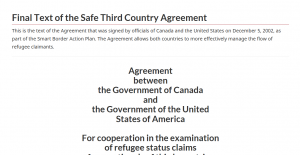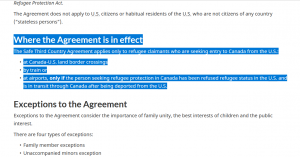

CLICK HERE, for full text for the Canada/US Safe 3rd Country Agreement.
THE UNDERSTANDING
From the opening of the agreement
EMPHASIZING that the United States and Canada offer generous systems of refugee protection, recalling both countries’ traditions of assistance to refugees and displaced persons abroad, consistent with the principles of international solidarity that underpin the international refugee protection system, and committed to the notion that cooperation and burden-sharing with respect to refugee status claimants can be enhanced;DESIRING to uphold asylum as an indispensable instrument of the international protection of refugees, and resolved to strengthen the integrity of that institution and the public support on which it depends;
NOTING that refugee status claimants may arrive at the Canadian or United States land border directly from the other Party, territory where they could have found effective protection;
CONVINCED, in keeping with advice from the United Nations High Commissioner for Refugees (UNHCR) and its Executive Committee, that agreements among states may enhance the international protection of refugees by promoting the orderly handling of asylum applications by the responsible party and the principle of burden-sharing;
AWARE that such sharing of responsibility must ensure in practice that persons in need of international protection are identified and that the possibility of indirect breaches of the fundamental principle of non-refoulement are avoided, and therefore determined to safeguard for each refugee status claimant eligible to pursue a refugee status claim who comes within their jurisdiction, access to a full and fair refugee status determination procedure as a means to guarantee that the protections of the Convention, the Protocol, and the Torture Convention are effectively afforded;
The wording is pretty clear here. Canada and the United States view each other as safe countries. If you land in one country, you “should” not be able to hop to the other and claim refugee status.
It is of interest to read in particular, articles 4, 5, 6
ARTICLE 4
Subject to paragraphs 2 and 3, the Party of the country of last presence shall examine, in accordance with its refugee status determination system, the refugee status claim of any person who arrives at a land border port of entry on or after the effective date of this Agreement and makes a refugee status claim.
Responsibility for determining the refugee status claim of any person referred to in paragraph 1 shall rest with the Party of the receiving country, and not the Party of the country of last presence, where the receiving Party determines that the person:
-Has in the territory of the receiving Party at least one family member who has had a refugee status claim granted or has been granted lawful status, other than as a visitor, in the receiving Party’s territory; or
-Has in the territory of the receiving Party at least one family member who is at least 18 years of age and is not ineligible to pursue a refugee status claim in the receiving Party’s refugee status determination system and has such a claim pending; or
-Is an unaccompanied minor; or
-Arrived in the territory of the receiving Party:
With a validly issued visa or other valid admission document, other than for transit, issued by the receiving Party; or
Not being required to obtain a visa by only the receiving Party.
The Party of the country of last presence shall not be required to accept the return of a refugee status claimant until a final determination with respect to this Agreement is made by the receiving Party.
Neither Party shall reconsider any decision that an individual qualifies for an exception under Articles 4 and 6 of this Agreement.
Makes clear about a formal point of entry. However, those who value sovereignty will note with concern there are many exceptions to keep alleged “refugees” in Canada far longer.
ARTICLE 5
In cases involving the removal of a person by one Party in transit through the territory of the other Party, the Parties agree as follows:
Any person being removed from Canada in transit through the United States, who makes a refugee status claim in the United States, shall be returned to Canada to have the refugee status claim examined by and in accordance with the refugee status determination system of Canada.
Any person being removed from the United States in transit through Canada, who makes a refugee status claim in Canada, and:
whose refugee status claim has been rejected by the United States, shall be permitted onward movement to the country to which the person is being removed; or
who has not had a refugee status claim determined by the United States, shall be returned to the United States to have the refugee status claim examined by and in accordance with the refugee status determination system of the United States.
It appears clear cut. You cannot country shop from one to another, and there is a specific agreement to remove those people who try.
ARTICLE 6
Notwithstanding any provision of this Agreement, either Party may at its own discretion examine any refugee status claim made to that Party where it determines that it is in its public interest to do so.
So, either Canada or the United States could remove anyone at any time if deemed in national interest.
HERE is the problem:
Where the Agreement is in effect
The Safe Third Country Agreement applies only to refugee claimants who are seeking entry to Canada from the U.S.:
-at Canada-U.S. land border crossings
-by train or
-at airports, only if the person seeking refugee protection in Canada has been refused refugee status in the U.S. and is in transit through Canada after being deported from the U.S.
As if plain and obvious, this only applies to border crossings entries. This means that fake refugees can bypass the agreement simply by entering anyplace other than an official border crossing.
That has been happening, by the thousands. See HERE, see HERE, and HERE.
One obvious solution would be to declare the “ENTIRE BORDER” a point of entry. However, there seems to be little willpower in Ottawa to do that.
In fact, Prime Minister Trudeau has no issues with calling a racist anyone who questions the open border.
